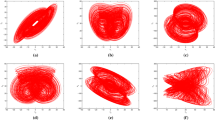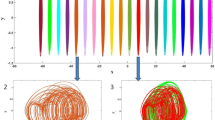Abstract
Finding chaotic oscillators with unique properties is a hot topic. In this paper, a symmetric oscillator with multi-stability is proposed. This oscillator has bounded dynamics for any initial conditions. It is also shown that the oscillator has one unstable equilibrium. This paper studies the dynamical properties of the oscillator, such as chaotic attractors, Lyapunov exponents (LEs), bifurcation diagrams, and the basin of attraction. Its feasibility is shown by circuit implementation. In addition, the stabilization of the system is investigated by impulsive control.








Similar content being viewed by others
References
S.H. Strogatz, Nonlinear Dynamics and Chaos with Student Solutions Manual: With Applications to Physics, Biology, Chemistry, and Engineering (CRC Press, Boca Raton, 2018)
S. Vaidyanathan, A.T. Azar, K. Rajagopal, A. Sambas, S. Kacar, U. Cavusoglu, A new hyperchaotic temperature fluctuations model, its circuit simulation, FPGA implementation and an application to image encryption. Int. J. Simul. Process Model. 13, 281–296 (2018)
X. Li, J. Mou, L. Xiong, Z. Wang, J. Xu, Fractional-order double-ring erbium-doped fiber laser chaotic system and its application on image encryption. Optic. Laser Technol. 140, 107074 (2021)
H. Hu, Y. Cao, J. Xu, C. Ma, H. Yan, An image compression and encryption algorithm based on the fractional-order simplest chaotic circuit. IEEE Access 9, 22141–22155 (2021)
F. Yu, Z. Zhang, L. Liu, H. Shen, Y. Huang, C. Shi, et al., Secure communication scheme based on a new 5D multistable four-wing memristive hyperchaotic system with disturbance inputs. Complexity 2020, 5859273 (2020)
K. Rajagopal, Y. Shekofteh, F. Nazarimehr, C. Li, and S. Jafari, A new chaotic multi-stable hyperjerk system with various types of attractors. Indian J. Phys. (2021). https://doi.org/10.1007/s12648-021-02075-4
K. Rajagopal, L. Guessas, A. Karthikeyan, A. Srinivasan, and G. Adam, Fractional order memristor no equilibrium chaotic system with its adaptive sliding mode synchronization and genetically optimized fractional order PID synchronization. Complexity 2017, 1892618 (2017)
C. Li, K. Rajagopal, F. Nazarimehr, Y. Liu, A non-autonomous chaotic system with no equilibrium. Integration 79, 143–156 (2021)
J.P. Singh, K. Rajagopal, B.K. Roy, A new 5D hyperchaotic system with stable equilibrium point, transient chaotic behaviour and its fractional-order form. Pramana 91, 1–10 (2018)
N. Sene, Introduction to the fractional-order chaotic system under fractional operator in Caputo sense. Alex. Eng. J. 60, 3997–4014 (2021)
Q. Xu, X. Tan, D. Zhu, H. Bao, Y. Hu, B. Bao, Bifurcations to bursting and spiking in the Chay neuron and their validation in a digital circuit. Chaos Solit Fractals 141, 110353 (2020)
C. Li, W. Hu, J.C. Sprott, X. Wang, Multistability in symmetric chaotic systems. Eur. Phys. J. Special Topics 224, 1493–1506 (2015)
C. Li, J.C. Sprott, H. Xing, Constructing chaotic systems with conditional symmetry. Nonlinear Dyn. 87, 1351–1358 (2017)
Z. Wei, I. Moroz, J.C. Sprott, Z. Wang, W. Zhang, Detecting hidden chaotic regions and complex dynamics in the self-exciting homopolar disc dynamo. Int. J. Bifurc. Chaos 27, 1730008 (2017)
Z. Wei, I. Moroz, J. Sprott, A. Akgul, W. Zhang, Hidden hyperchaos and electronic circuit application in a 5D self-exciting homopolar disc dynamo. Chaos: Interdisciplin. J. Nonlinear Sci. 27, 033101 (2017)
J.C. Sprott, S. Jafari, A.J.M. Khalaf, T. Kapitaniak, Megastability: Coexistence of a countable infinity of nested attractors in a periodically-forced oscillator with spatially-periodic damping. Eur. Phys. J. Special Topics 226, 1979–1985 (2017)
B. Bao, H. Bao, N. Wang, M. Chen, Q. Xu, Hidden extreme multistability in memristive hyperchaotic system. Chaos Solit. Fractals 94, 102–111 (2017)
B.-C. Bao, Q. Xu, H. Bao, M. Chen, Extreme multistability in a memristive circuit. Electron. Lett. 52, 1008–1010 (2016)
G. Leonov and N. Kuznetsov, Analytical-numerical methods for investigation of hidden oscillations in nonlinear control systems. IFAC Proc. Volumes (IFAC PapersOnline) 18(Pt. 1), 2494–2505 (2011)
Z. Wei, W. Zhang, Z. Wang, M. Yao, Hidden attractors and dynamical behaviors in an extended Rikitake system. Int. J. Bifurc. Chaos 25, 1550028 (2015)
B.C. Bao, P. Jiang, Q. Xu, M. Chen, Hidden attractors in a practical Chua’s circuit based on a modified Chua’s diode. Electron. Lett. 52, 23–25 (2016)
Y. Feng, K. Rajagopal, A.J.M. Khalaf, F.E. Alsaadi, F.E. Alsaadi, V.-T. Pham, A new hidden attractor hyperchaotic memristor oscillator with a line of equilibria. Eur. Phys. J. Special Topics 229, 1279–1288 (2020)
Z. Wei, Dynamical behaviors of a chaotic system with no equilibria. Phys. Lett. A 376, 102–108 (2011)
K. Rajagopal, A. Karthikeyan, A.K. Srinivasan, FPGA implementation of novel fractional-order chaotic systems with two equilibriums and no equilibrium and its adaptive sliding mode synchronization. Nonlinear Dyn. 87, 2281–2304 (2017)
A.J.M. Khalaf, T. Kapitaniak, K. Rajagopal, A. Alsaedi, T. Hayat, V.-T. Pham, A new three-dimensional chaotic flow with one stable equilibrium: dynamical properties and complexity analysis. Open Phys. 16(1), 260–265 (2018)
Z. Wei, Q. Yang, Dynamical analysis of a new autonomous 3-D chaotic system only with stable equilibria. Nonlinear Anal. Real World Appl. 12, 106–118 (2011)
M. Chen, Y. Feng, H. Bao, B. Bao, Y. Yu, H. Wu et al., State variable mapping method for studying initial-dependent dynamics in memristive hyper-jerk system with line equilibrium. Chaos Solit. Fractals 115, 313–324 (2018)
Y. Chen, Q. Yang, A new Lorenz-type hyperchaotic system with a curve of equilibria. Math. Comput. Simul. 112, 40–55 (2015)
J.C. Sprott, Elegant Chaos: Algebraically Simple Chaotic Flows (World Scientific, Singapore, 2010)
L. Chunxia, Y. Jie, X. Xiangchun, A. Limin, Q. Yan, F. Yongqing, Research on the multi-scroll chaos generation based on Jerk mode. Procedia Eng. 29, 957–961 (2012)
R.C. Hilborn, Chaos and Nonlinear Dynamics: An Introduction for Scientists and Engineers (Oxford University Press on Demand, Oxford, 2000)
J.C. Sprott Chaos and Time-Series Analysis (Oxford University Press, Oxford, 2003)
A. Wolf, J.B. Swift, H.L. Swinney, J.A. Vastano, Determining Lyapunov exponents from a time series. Physica D 16, 285–317 (1985)
J.B. Dingwell, Lyapunov exponents, in Wiley encyclopedia of biomedical engineering, (2006)
Q. Lai, Z. Wan, P.D.K. Kuate, H. Fotsin, Coexisting attractors, circuit implementation and synchronization control of a new chaotic system evolved from the simplest memristor chaotic circuit. Commun. Nonlinear Sci. Numer. Simul. 89, 105341 (2020)
V. Sundarapandian, I. Pehlivan, Analysis, control, synchronization, and circuit design of a novel chaotic system. Math. Comput. Model. 55, 1904–1915 (2012)
C. Pan, Q. Hong, X. Wang, A novel memristive chaotic neuron circuit and its application in chaotic neural networks for associative memory. IEEE Trans. Comput. Aided Des. Integr. Circuits Syst. 40, 521–532 (2020)
Z. Yuan, H. Li, Y. Miao, W. Hu, X. Zhu, Digital-analog hybrid scheme and its application to chaotic random number generators. Int. J. Bifurc. Chaos 27, 1750210 (2017)
Z. Wei, V.-T. Pham, T. Kapitaniak, Z. Wang, Bifurcation analysis and circuit realization for multiple-delayed Wang-Chen system with hidden chaotic attractors. Nonlinear Dyn. 85, 1635–1650 (2016)
B. Xu, D. Han, P. Liu, Q. Liu, A. Zhang, S. Ma et al., Enhanced luminescence property of InGaN/GaN nanorod array light emitting diode. Opt. Eng. 58, 045102 (2019)
M. Hua, H. Wu, Q. Xu, M. Chen, B. Bao, Asymmetric memristive Chua’s chaotic circuits. Int. J. Electron. 108, 1106–1123 (2021)
X. Ren, B. Chen, Q. Xu, et al., Parameter and initial offset boosting dynamics in two-memristor-based Colpitts system. Eur. Phys. J. Spec. Top. 230, 1709–1721 (2021). https://doi.org/10.1140/epjs/s11734-021-00118-9
H. Wu, B. Bao, Z. Liu, Q. Xu, P. Jiang, Chaotic and periodic bursting phenomena in a memristive Wien-bridge oscillator. Nonlinear Dyn. 83, 893–903 (2016)
Q. Xu, Y. Lin, B. Bao, M. Chen, Multiple attractors in a non-ideal active voltage-controlled memristor based Chua’s circuit. Chaos Solit. Fractals 83, 186–200 (2016)
C. Li, Y. Yang, J. Du, and Z. Chen, A simple chaotic circuit with magnetic flux-controlled memristor. Eur. Phys. J. Special Topics 230, 1–14 (2021)
Q. Jin, F. Min, C. Li, Infinitely many coexisting attractors of a dual memristive Shinriki oscillator and its FPGA digital implementation. Chin. J. Phys. 62, 342–357 (2019)
M. Jun-hai, R. Biao, C. Yu-shu, Impulsive control of chaotic attractors in nonlinear chaotic systems. Appl. Math. Mech. 25, 971–976 (2004)
G. X.-P. F. Zheng-Ping ,P. H.-P. W. Yi-Qun, The adaptive control of Chen’s chaotic system [J]. Acta Physica Sinica 11, 2108–2111 (2001)
X. Liu, S. Zhong, T-S fuzzy model-based impulsive control of chaotic systems with exponential decay rate. Phys. Lett. A 370, 260–264 (2007)
D. Chen, J. Sun, C. Huang, Impulsive control and synchronization of general chaotic system. Chaos Solit. Fractals 28, 213–218 (2006)
J. Zhou, X. Cheng, L. Xiang, Y. Zhang, Impulsive control and synchronization of chaotic systems consisting of Van der Pol oscillators coupled to linear oscillators. Chaos Solit. Fractals 33, 607–616 (2007)
T. Yang, Impulsive Control Theory, vol. 272 (Springer Science & Business Media, Berlin, 2001)
Z.G. Li, C.Y. Wen, Y.C. Soh, Analysis and design of impulsive control systems. IEEE Trans. Autom. Control 46, 894–897 (2001)
Acknowledgements
This work is partially supported by the Natural Science Basic Research Program of Shaanxi (2021JM-533, 2021JQ-880, 2020JM-646), the Innovation Capability Support Program of Shaanxi (2018GHJD-21), the Science and Technology Program of Xi’an (2019218414GXRC020CG021-GXYD20.3), the Support Plan for Sanqin Scholars Innovation Team in Shaanxi Province of China and the Scientific Research Fund for High-Level Talents of Xijing University (XJ21B01). This work is partially funded by Centre for Nonlinear Systems, Chennai Institute of Technology, India vide funding number CIT/CNS/2021/RD/064.
Author information
Authors and Affiliations
Rights and permissions
About this article
Cite this article
Wang, Z., Veeman, D., Zhang, M. et al. A symmetric oscillator with multi-stability and chaotic dynamics: bifurcations, circuit implementation, and impulsive control. Eur. Phys. J. Spec. Top. 231, 2153–2161 (2022). https://doi.org/10.1140/epjs/s11734-021-00371-y
Received:
Accepted:
Published:
Issue Date:
DOI: https://doi.org/10.1140/epjs/s11734-021-00371-y




